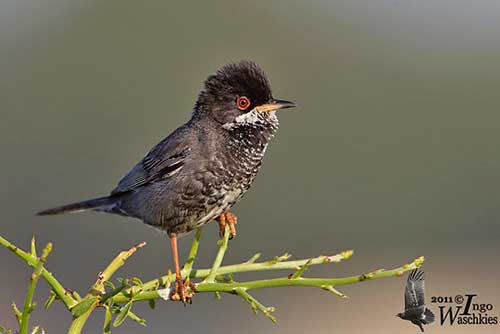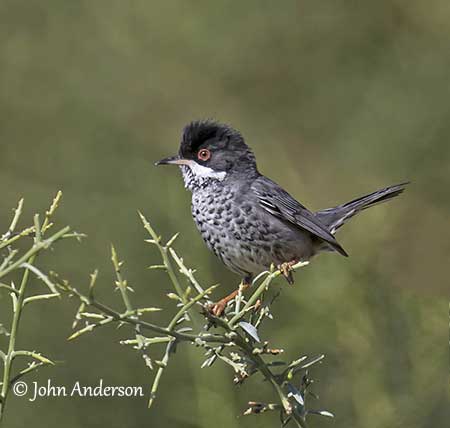
Photographers:
John Anderson
John Anderson Photo Galleries
Ingo Waschkies
Bird Photography
Text by Nicole Bouglouan
Sources:
HANDBOOK OF THE BIRDS OF THE WORLD Vol 11 by Josep del Hoyo, Andrew Elliott and David Christie - Lynx Edicions - ISBN: 849655306X
THE HANDBOOK OF BIRD IDENTIFICATION FOR EUROPE AND THE WESTERN PALEARCTIC by Mark Beaman, Steve Madge - C. Helm - ISBN: 0713639601
BIRDS OF THE MIDDLE EAST by R.F. Porter, S. Christensen, P Schiermacker-Ansen C.Helm - ISBN: 0713670169
L’ENCYCLOPEDIE MONDIALE DES OISEAUX - Dr Christopher M. Perrins - BORDAS - ISBN: 2040185607
Wikipedia, the free encyclopaedia
Endemic Cyprus Warbler and colonizing Sardinian Warbler show different habitat associations
The Conference Call Of The Birds
Bird Conservation International
Cyprus Warbler
Sylvia melanothorax
Passeriformes Order – Sylviidae Family
INTRODUCTION:
The Cyprus Warbler is the national bird of Cyprus. It is endemic to this island where it is resident and partially migratory. It is often very active with its tail cocked while foraging among the vegetation. It is usually heard before to be seen, because it favours the vegetal cover. But the hoarse alarm call betrays its presence.
The Cyprus Warbler is not globally threatened, but changes in the habitat due to agriculture expansion and urban development involve some declines in the global population.

DESCRIPTION OF THE BIRD:
Biometrics:
Length: 13 cm
Wingspan: 15-18 cm
Weight: 9,5-15 g
The Cyprus Warbler resembles Sardinian Warbler, but it differs by the heavily black-spotted underparts.
The male in breeding plumage has blackish head and dark grey upperparts. On the upperwing, coverts, alula and flight-feathers have blackish centres and pale grey fringes. The tail is blackish with whitish edges and tips to outer rectrices.
The underparts shows varying amount of black spots and blotches, including on the undertail-coverts.
We can see a conspicuous white moustachial stripe on the black head.
The two-tone bill has blackish culmen and tip, whereas the base is flesh-grey to pink. The eyes are reddish-brown, surrounded by red, bare orbital ring. Legs and feet are pinkish-brown.
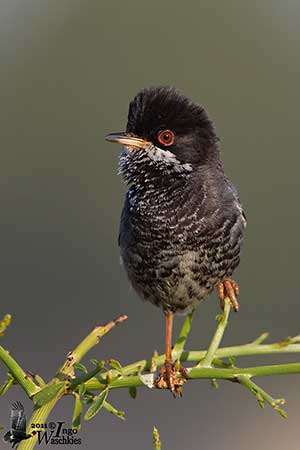
The non-breeding male is fairly similar but with pale grey fringes on crown and less conspicuous black pattern below. Eyes and eyering are duller.
The female and the first winter male have mottled black crown and faint whitish moustachial stripe, grey-brown upperparts and mottled dark grey throat and breast. Legs and feet are reddish-brown.
The first winter female has uniform grey-brown crown and very few or no spots on underparts.
The juvenile is very similar to juvenile Sardinian Warbler.
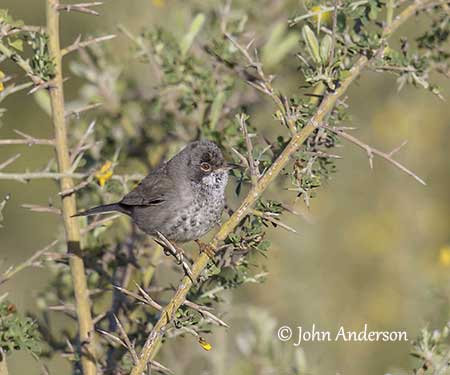
RANGE:
The Cyprus Warbler is endemic to Cyprus where it breeds. Outside breeding season, it is found along narrow strips of Red Sea coast, from NE Egypt, E to Arava depression and NW Saudi Arabia, and S to NE Sudan.
HABITAT:
The Cyprus Warbler breeds in well vegetated rocky slopes and foothills, open oak and pine forests with bushy undergrowth, dense scrub country and maquis, from sea-level up to 1400 metres of elevation.
During winter, it frequents acacia scrubs and less vegetated areas, both in lowlands and coastal regions. It may frequent dry and semi-arid areas with low scrubby vegetation. On migration, it often frequents tamarisk thickets (Tamarix).
CALLS AND SONGS: SOUNDS BY XENO-CANTO
The Cyprus Warbler’s calls include a sharp, grating “tchek” used as contact call. It also utters prolonged ticking rattle and a sudden churring rattle “tcharr-tcharr-tcharr-tcharr…” more prolonged and softer than that of Sardinian Warbler. The alarm call is composed of hard “tk” notes.
The song includes vigorous chatters with rattling and loud sounds. It often varies in pitch and intensity. It is often given from bush or sometimes in flight.
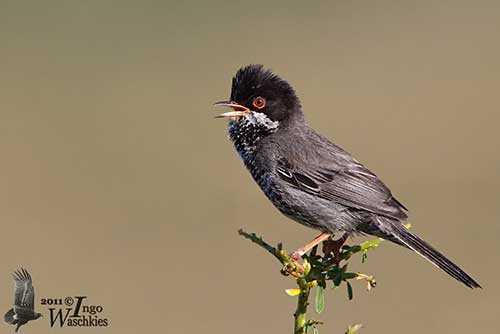
BEHAVIOUR IN THE WILD:
The Cyprus Warbler feeds mainly on invertebrates such as spiders, flies, midges and butterflies. Berries can be eaten after the breeding season.
It forages in low bushes or scrubs, and more rarely in trees or on the ground. It moves low down from bush to bush, and picks invertebrates from vegetation and branches. It is usually seen single, but also in pairs or family groups, depending on the season. It may form small groups of 10-30 individuals outside breeding season.
The Cyprus Warbler is monogamous and breeds solitary. It is territorial during this period, and the male becomes bold on its territory. It perches out in the open, and occasionally performs a half-hearted song flight, often caused by competition between rival males. The bird moves from perch to perch with slow, exaggerated wingbeats. It builds unlined nests, but the breeding nest is made by the female.
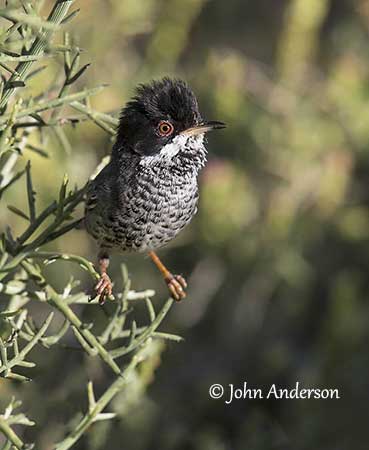
The Cyprus Warbler is partially migratory, with some birds remaining on the breeding grounds whereas others perform short-distance and /or altitudinal movements to reach lowlands and coastal areas of Cyprus. It is less common in winter on the island.
They leave the breeding grounds in late September/October, and cross the Mediterranean Sea towards the wintering grounds. They leave them between January and mid-March. The first arrivals at the breeding areas occur from late February to March.
The Cyprus Warbler has swift flight with rapid wingbeats.
REPRODUCTION OF THIS SPECIES:
The breeding season takes place in spring, with peak laying in April-May in lowlands, and up to June at higher elevations.
The Cyprus Warbler’s nest is built by the female in low bush. She builds an open cup with grass, stems and leaves, held together with spider webs. The cup is lined with soft material including finer grass, spider webs and hair. Some pieces of bark are added on the outer part of the cup. The nest is placed between 30 and 120 centimetres above the ground.
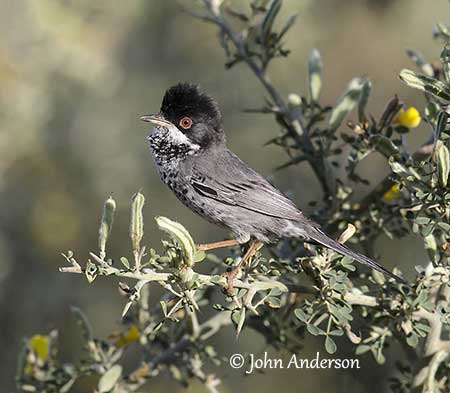
The female lays 3-5 eggs and performs most of the incubation but the duration is unknown. The chicks are fed by both parents. They remain at nest at least 10 days. They still depend on parents for two weeks or more after fledging.
This species usually produces a single brood per season, but more information is needed.
PROTECTION / THREATS / STATUS:
The Cyprus Warbler has restricted range, and the species is common in suitable habitat. Some declines occurred in areas colonized by the Sardinian Warbler.
The global population was estimated to number 70,000/140,000 pairs in 2015. It is threatened by changes in farming and agricultural expansion, urban development, pesticides, netting and shooting.
But currently, the Cyprus Warbler is evaluated as Least Concern.
